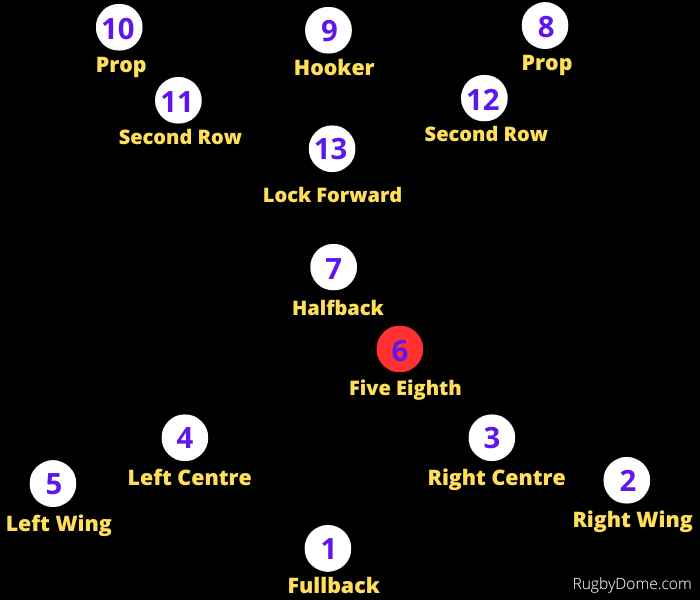The five-eighth is also known as the stand-off or pivot in rugby league. There is one five-eighth on a league team and they traditionally wear the number six jersey.
The five-eighth is one of the primary playmakers on the team. In other words, they initiate and direct the attack.
This article looks at the crucial role of rugby league halfbacks in league
Positioning
Although scrums aren’t as important in rugby league nowadays, it’s still helpful to show where the five-eighth stands in relation to the other players.
This picture shows their position during a scrum.

Why Are They Called Five-Eighths?
The name comes from the early history of the sport before it split into rugby league and rugby union (the 15-player version of the sport).
In the early 19th century days, there were only two specialist positions: everybody was either a forward or a back. The backs’ positions were numbered based on the fraction of the distance they stood from the forwards.
In this numbering system, the halfback was called the “half” because they were positioned halfway between the forwards and the fullback.
The five-eighth was positioned between the halfback and the three-quarter line (centers and wingers), which placed them at a “five-eighths” distance between the forwards and the fullback.
That’s how they got the name of five-eighth.
What Do Five-Eighths Do In Attack?
The Five-Eighth plays a key role in attack as they share the playmaking role with the halfback. This may involve initiating a set play with the halfback, executing a pre-planned move, or adapting to the opposition’s defensive formation on the fly.
They often receive the ball from the dummy half. They decide whether to pass to forwards, other playmakers, or outside backs.
They may also decide to take on the defensive line themselves. By creating line breaks, drawing defenders, or offloading the ball to teammates, they can create space and opportunities for their team to score.
Five-Eighths employ a variety of tactical kicks to create scoring opportunities, apply pressure on the opposition, or gain field position advantages. This can include grubber kicks, chip kicks, cross-field kicks, or bombs.
Working With Their Halfback
Their relationship with the halfback (also called the scrum-half) is crucial for the team’s attacking play.
The halfback is more of an organizer, while the five eighth is often the next player who receives the ball.
The halfback is less likely to run hard into contact. In contrast, the five-eighth gets more involved in direct running. The two are constantly communicating throughout a game.
Role Of Five-Eighths In Defence
Five-Eighths usually position themselves alongside the halfbacks and centres in the defensive line.
Although more prominent in attack, they must make their tackles when the ball-carrier enters their zone.
How The Role Has Changed Over Time
The role of the five-eighth in rugby league has evolved significantly over the years.
In the early days of rugby league, the halfback was the primary playmaker and ball distributor. The five-eighth played a more supportive role. In the modern era, the stand-off has become a second playmaker.
As kicking has grown more important in the sport, the five-eighth role has assumed a lot of the responsibility for making effective kicks.
The five-eighths role in defense has also increased. They are now expected to contribute more in terms of tackling and maintaining the defensive line.
Famous Five-Eighths In League History
Here are two famous stand-offs from two different countries.
Wally Lewis
Wally Lewis started his league career with the Brisbane club Valleys Diehards in the late 1970s. He also played for Wynumm-Manly and Brisbane Broncoes.
But he made his name with Queensland in the State of Origin. He played in thirty-one games through the 1980s, and was captain for all but one of them.
Lewis also captained the Kangaroos twenty-three times out of thirty-three tests.
Kevin Sinfield
Kevin Sinfield moved back and forth between lock forward and stand-off.
Born in Greater Manchester, he played for the Leeds Rhinos for an astonishing eighteen years, after joining them in 1997. He was captain for the latter twelve of those years.
He led the Rhinos to seven Super League Titles between 2004 and 2015. He also captained England to the semi-final of the 2013 World Cup.